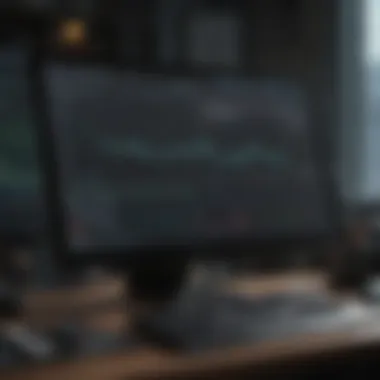ThinkorSwim PC Requirements for Optimal Trading


Intro
Navigating the world of trading can be a complex venture, especially when coupled with the right tools. One of the crucial instruments in this landscape is the ThinkorSwim platform, a robust solution for those serious about their trading activities. But before you dive headfirst into the markets, it’s vital to ensure your computer meets the specific requirements that guarantee not just usability but also optimal performance. Whether you are a seasoned trader or a newcomer, understanding the technical aspects of ThinkorSwim will enhance your experience and performance.
This article will offer a detailed guide on the essential PC requirements tailored specifically for ThinkorSwim. The realm of trading is filled with dynamic data, rapid market changes, and real-time information. To keep pace, you must ensure your setup can handle these demands without a hitch. Here, we delve into hardware specifications, the necessary software, and best practices aimed at maximizing your trading efficiency.
We will touch on aspects ranging from processor requirements to graphic card capabilities, alongside tips on maintaining a smooth user experience. Let's embark on a journey to make sure your trading platform operates at peak capacity, giving you the edge in today’s fast-moving markets.
Prelims to ThinkorSwim
With the world of trading becoming increasingly digital, the tools traders use can significantly impact their performance. One such tool is ThinkorSwim, a versatile platform that offers robust features for both novice and seasoned investors. Understanding ThinkorSwim goes beyond just knowing it as a platform; it involves grasping the implications of its system requirements on your overall trading experience.
Overview of ThinkorSwim
ThinkorSwim, developed by TD Ameritrade, dives deep into the heart of trading and investing by providing real-time data, advanced charting capabilities, and a comprehensive suite of analytical tools. The platform caters to a wide range of assets, including stocks, options, futures, and forex. Its customizable interface allows traders to tweak their setup to suit their unique trading needs and styles. Amidst its myriad features, the platform stands out for its educational resources, crucial for traders looking to refine their skills. From virtual trading to in-depth market analysis, ThinkorSwim serves as an all-in-one trading hub, enabling users to navigate the complexities of the financial markets efficiently.
Importance of System Requirements
When diving into ThinkorSwim's features, it's critical to recognize that the performance of the platform hinges on certain technical specifications. These requirements aren't just afterthoughts; they are fundamental to ensuring that users experience seamless interactions with the software.
Having the right system requirements allows traders to capitalize on the platform's full functionality without hiccups. For instance, slow processing speeds or insufficient memory can lead to delays in executing trades or processing real-time data. In trading, where split-second decisions can result in significant financial outcomes, delays can be detrimental. It’s akin to driving a sports car with a flat tire – even if you have the best vehicle, performance will remain compromised if you neglect critical maintenance.
"A trader is only as good as the tools they use."
It's not merely about the software, but how well it integrates with your hardware. This article aims to elucidate the minimum and recommended PC requirements for ThinkorSwim, ensuring that your trading experience is not just functional, but optimized for performance.
Considering the complexities and demands of modern trading, understanding these requirements is essential. This foundational knowledge directly translates to efficiency, reliability, and ultimately, success in your trading endeavors.
Minimum Hardware Specifications
In the fast-paced realm of trading, low latency and high responsiveness are paramount. Consequently, understanding the minimum hardware specifications for ThinkorSwim is the foundation for ensuring a seamless trading experience. These specifications serve as the baseline to support the platform's functionality without unnecessary hiccups. Let’s dive into the nitty-gritty of what you need under the hood.
Processor Requirements
When it comes to processors, you want something that won’t leave you in the dust. A minimum of an Intel i3 or AMD Ryzen 3 is recommended. While trading, you'll be crunching numbers and analyzing charts in real-time. A more powerful processor, like the Intel i5 or Ryzen 5, can significantly speed up execution and reduce lag during high market activity.
In layman's terms, think of it like this: A trading strategy can be likened to a recipe. If your processor is a high-quality oven, it will cook up your trades more efficiently. A sluggish processor can often lead to unwanted delays, potentially costing you in a volatile market.
Memory and RAM Specifications
Memory, specifically RAM, is also very important. For ThinkorSwim, aim for at least 8GB of RAM. This amount enables you to run multiple applications smoothly, which is crucial when toggling between charts, news feeds, and your trading platform itself. If your budget allows, bumping that up to 16GB can make a noticeable difference in performance.
Think of RAM like your workspace. The more room you have, the easier it is to spread out and work without things getting cluttered. With enough RAM, your trading experience will be as smooth as butter.
Storage Space Considerations
A common oversight is the type of storage being used. While many users think that just having adequate storage space is sufficient, the type and speed of storage can hugely impact performance. A minimum of 256GB SSD (Solid State Drive) is highly recommended over traditional hard drives.
SSDs are faster and tend to load applications swiftly. It’s like moving from a bicycle to a sports car—you get to your destination quicker. Imagine waiting for your system to boot while missing out on market opportunities—definitely not ideal.
Graphics Card Specifications
In trading, you might think that graphics cards are the last thing you need, but that’s a common misunderstanding. While ThinkorSwim is not a graphics-intensive program, having a dedicated graphics card can enhance the display of complex charts and improve overall multitasking performance. Aim for at least an NVIDIA GeForce GTX 1050 or an equivalent AMD model.
Having a capable graphics card means your visuals are crisp and responsive, which can make a huge difference when interpreting data. A good card will allow you to utilize multiple monitors effectively, providing a more expansive view of your trading landscape.


Important Note: Don’t overlook these specs as they are the building blocks for a reliable trading setup. Just as good tools are essential for a craftsman, the right hardware elevates your trading game.
Recommended Hardware Specifications
When diving into the world of ThinkorSwim, understanding the recommended hardware specifications is pivotal for ensuring that your trading experience is as smooth as silk. With trading platforms, performance can hinge on the capabilities of your PC. If your setup is lacking, you might find yourself at a disadvantage, potentially missing out on golden trading opportunities.
Optimizing Processor Performance
Your processor serves as the brain of your computer. Think of it as a conductor leading an orchestra—efficiently coordinating all the elements of your trading experience. For ThinkorSwim, opting for a multi-core processor, particularly those from the Intel Core i5 or i7 line or AMD Ryzen 5 or 7 series, tends to yield favorable results. These processors not only handle multiple tasks simultaneously but also ensure that data crunching happens swiftly.
When considering how to optimize processor performance, look into a few key factors:
- Clock Speed: A higher clock speed can boost the time it takes to execute commands.
- Core Count: More cores allow for better multitasking, vital when you're running several applications alongside ThinkorSwim.
- Thermal Management: Ensure that your cooling system is up to snuff to prevent throttling during peak processing times.
In the end, investing in a robust processor can prevent annoying lags that disrupt your trading momentum.
Enhancing Memory Capacity for Performance
Memory, generally known as RAM, is like a temporary workspace for your data. ThinkorSwim can be quite the memory hog, especially when running charts, indicators, and multiple watchlists. As a rule of thumb, having at least 16GB of RAM is advisable. This amount allows smoother navigation between various functionalities and faster data retrieval.
Furthermore, enhancing memory capacity involves:
- Using Dual Channel Configuration: This method can effectively double the bandwidth available to your RAM, speeding up data transfers.
- Opting for Faster RAM Speeds: RAM rated at 3200 MHz or higher can improve performance noticeably.
- Monitoring Memory Usage: Occasionally check your memory usage to see if upgrading to 32GB is beneficial, especially for intensive trading strategies.
Storage Options for Efficiency
When it comes to storage, having a solid-state drive (SSD) rather than a traditional hard disk drive (HDD) makes a significant difference. Think of SSDs as the fast lane while HDDs are more like the scenic route. An SSD dramatically decreases load times, meaning ThinkorSwim initializes in a flash. A minimum of 512GB SSD storage is optimal, especially when dealing with multiple data points, charts, and profile setups.
For the best performance:
- Consider NVMe Drives: They are faster than SATA SSDs, which can make a substantial impact on performance.
- Keep Your Drive Clean: Regularly deleting unnecessary files helps maintain speed and efficiency.
- Partition for Efficiency: Splitting your storage can organize data better, making retrieval more straightforward.
Choosing the Right Graphics Card
A capable graphics card is often the unsung hero of trading setups. It renders high-resolution charts effortlessly. ThinkorSwim isn’t particularly demanding in this area, but a dedicated graphics card still improves your experience, especially when you need to analyze complex datasets.
Aim for a mid-range graphics card, like the NVIDIA GTX 1660 or an AMD Radeon RX 580, they deliver the performance without breaking the bank. Keep these points in mind:
- VRAM: At least 4GB of dedicated video memory is a good baseline for handling multiple monitors.
- Driver Updates: Regularly updating your graphics card drivers is crucial to maintain peak performance and compatibility with ThinkorSwim.
- Performance Monitoring: Utilize tools that can analyze graphics performance during heavy usage to prevent potential bottlenecks.
To sum up, investing in these hardware specifications not only enhances the usability of ThinkorSwim but ultimately leads to more decisive and informed trading actions. A well-optimized PC can be the difference between seizing opportunities and letting them slip through your fingers.
Operating System Requirements
Understanding the operating system requirements for ThinkorSwim is crucial for traders looking to have a smooth and efficient trading experience. The operating system serves as the backbone of your entire computing environment, and ensuring compatibility is not just a technical detail; it can enhance performance and reliability while minimizing disruptions during trading time. An incompatible or outdated operating system can lead to errors and crashes, causing you to miss out on critical trading opportunities.
Supported Operating Systems
ThinkorSwim is compatible with several operating systems, mainly focusing on Windows and macOS. Windows 10 and Windows 11 are often recommended for their cutting-edge features and security updates. Here’s a more detailed look:
- Windows 10: Versions Home, Pro, and Enterprise are all supported. Having the latest update is highly recommended to keep your software running smoothly.
- Windows 11: This is the newer alternative, which not only offers enhanced security but also supports the latest features that can optimize your trading.
- macOS: While the platform is primarily geared toward Windows users, ThinkorSwim is also available for macOS, supporting versions from macOS Mojave (10.14) onward. So if you're on a Mac, ensure your operating system is up to date to avoid performance hiccups.
It’s important to note that running an unsupported operating system may yield unpredictable results, potentially leading to issues in the platform’s functionality.


Software Updates and Compatibility
Regular software updates play a pivotal role in maintaining your ThinkorSwim experience. Both ThinkorSwim itself and your operating system need to be kept in sync. Installing updates not only provides new features but also patches any vulnerabilities.
"Ignoring software updates is like leaving your front door unlocked in a bad neighborhood; you’re inviting trouble!"
Here are some critical points regarding software compatibility and updates:
- Automatic Updates: Most operating systems allow for automatic updates. Engaging this feature can save you time and ensure you are always running the latest version of your operating system.
- Compatibility: Check that your ThinkorSwim version aligns with your operating system. The application generally requires the latest stable versions for best results. Keeping up with news about updates through forums like reddit.com can offer insights and potential pitfalls.
- Backup: Before proceeding with any update, make sure you back up your data. A corrupted update can affect your trading information, something you surely don’t want to deal with during crucial market times.
Staying ahead of these requirements will ensure a seamless operation of ThinkorSwim, paving the way for an optimal trading setup.
Network and Internet Requirements
In the fast-paced realm of trading, minimizing lag and ensuring timely data access is paramount. Without a robust network and stable internet connection, even the most sophisticated trading setups can falter. ThinkorSwim is inherently designed to provide real-time data and analytics. Thus, understanding the network and internet requirements is vital for optimizing your trading experience.
Recommended Internet Speed
When it comes to internet speed, aiming for a minimum download speed of 10 Mbps is generally considered suitable for ThinkorSwim. However, if you're trading with high-frequency strategies, then faster speeds, ideally over 25 Mbps, are advisable.
Additionally, consider the upload speed as well. An upload speed of around 3 Mbps is generally sufficient, but having more can ensure that your trades are executed without delay. Keep in mind that consistent speed matters more than mere peak speeds; sudden drops in connection speed can lead to missed trades and potential losses.
To get a clear picture of your internet speed, run speed tests regularly. Tools like Speedtest.net can help assess your connection's current performance.
Network Configuration for Stability
Stability in your network configuration can significantly impact your trading performance. Here are several critical considerations:
- Wired vs. Wireless: Whenever possible, opt for a wired Ethernet connection instead of Wi-Fi. Wired connections are generally more stable and less prone to interference.
- Router Quality: Invest in a high-quality router that can handle multiple devices if you have a home network. A dual-band router can improve performance by allowing you to connect to both 2.4GHz and 5GHz bands.
- Network Traffic Management: If your household has multiple users streaming video or using bandwidth-heavy applications, consider configuring Quality of Service (QoS) settings on your router. This prioritizes trading traffic, ensuring that your connection remains stable even when multiple devices are active.
- Regular Reboots: Occasionally reboot your modem and router. This can clear out minor glitches that accumulate over time and keep your connection fresh.
By focusing on these network and internet requirements, you set the foundation for an efficient trading environment.
"A reliable connection is the backbone of successful trading; don't take it for granted."
Taking the time to understand and implement these recommendations can help you avoid pitfalls in your trading journey.
Common Issues and Troubleshooting
In the fast-paced world of trading, having your tools function at their best is key. ThinkorSwim is a powerful platform, but even the mightiest of machines can hit a snag. A solid grounding in common issues and troubleshooting techniques can be the difference between watching profits slip away and making informed decisions quickly. By pinpointing problems effectively, traders can avoid the pitfalls that can lead to costly mistakes.
Identifying Performance Bottlenecks
When your system runs slower than molasses in January, it’s often a bottleneck causing the mayhem. It’s vital for traders to constantly monitor system performance. Various factors can contribute to this sluggishness, such as inadequate hardware specs, network issues, or software conflicts. Look for these telltale signs:
- Laggy Interface: If clicking on tabs feels as if you're pushing a boulder uphill, that’s an indicator of trouble.
- Slowed Data Refresh Rates: Price quotes or charts that don’t update in real-time can lead to missed trading opportunities.
- Error Messages: Frequent crashes or error notifications indicate that something's amiss.
Aside from noticeable symptoms, using built-in tools like Task Manager (for Windows) or Activity Monitor (for Mac) can help you see where resources are being consumed. Check for processes that hog CPU or RAM.
Problem-Solving Steps
When things go awry, having a systematic approach helps tackle issues effectively. Here’s a step-by-step guide to untangle the mess:
- Restart the Application: Sometimes a simple restart can douse flames of frustration. Close the ThinkorSwim program and relaunch it to clear temporary glitches.
- Check Internet Connection: Ensure your network is stable. A slow or intermittent connection can wreak havoc on trading platforms.
- Update Software: Keeping your ThinkorSwim and operating system up-to-date can squash bugs and improve performance.
- Inspect Hardware: Check that your hardware meets the recommended specifications. Upgrading memory or storage can yield substantial performance improvements.
- Clear Cache: Over time, cached data can accumulate. Clear this out by navigating to the settings in the ThinkorSwim application.
- Seek Support: If all else fails, it’s wise to reach out to TD Ameritrade’s support team or local forums such as Reddit to seek advice from experienced users.


"Your equipment is just as important as your strategy when trading. Don’t cut corners here; adapt and overcome!"
By being vigilant and following these steps, users can troubleshoot effectively, ensuring that their trading experience remains fluid and efficient.
Best Practices for System Maintenance
Maintaining an efficient trading system is crucial if one wants to maximize their experience with ThinkorSwim. These best practices will keep your system running smoothly, prevent slowdowns, and ensure that you are always ready to react to market changes. In this section, we will delve into three key areas: regular software updates, routine hardware checks, and optimizing system settings.
Regular Software Updates
Software updates are like regular oil changes for your car – vital for keeping everything operating at peak performance. ThinkorSwim frequently rolls out updates that not only enhance functionality but also address security vulnerabilities. Ensuring your trading software is up to date means you're working with the latest features and improvements.
When applying updates, consider the following elements:
- Performance Enhancements: New versions can have modifications that enhance speed and responsiveness, which are critical during fast market movements.
- Bug Fixes: Regular updates often resolve existing issues; staying current means fewer disruptions during trading sessions.
- Security: Each update may contain important security patches. Ignoring these can leave your system susceptible to attacks or harmful software.
It’s advisable to enable automatic updates. This way, you can avoid the hassle and worry about missing crucial patches. Just ensure that the updates occur during low-traffic hours to avoid interfering with your trading activities.
“An ounce of prevention is worth a pound of cure.” Keeping software updated might seem like a simple task, but it plays a significant role in overall performance and security.
Routine Hardware Checks
Hardware checks are just as important as software updates. A well-maintained machine helps avoid unexpected downtimes that can cost you dearly in volatile markets. Regular inspections allow you to spot early signs of wear and tear, helping you to forestall potential problems.
Here are a few elements worth looking into during routine maintenance:
- Dust and Cleanliness: Dust accumulation can lead to overheating, potentially damaging components. Regular internal cleaning can keep your system operating without glitches.
- Hard Drive Health: Use utilities to check disk health and integrity. Look out for any signs of failure, so you can back up important data before it’s too late.
- Peripheral Checkups: Ensure that all peripherals such as your monitor, keyboard, and mouse are functioning properly. A faulty mouse can hinder your trading efficiency.
It's worth investing in hardware monitoring tools that alert you before problems escalate, which can thwart potential disruptions when it’s time to start trading.
Optimizing System Settings
Optimizing your settings can make a significant difference in how smoothly ThinkorSwim operates. It isn’t just about having a powerful machine; it’s also about customizing it to your needs. Small adjustments can yield noticeable improvements in performance.
Consider these fine-tuning options:
- Visual Settings: Adjust graphics options to balance performance with visual clarity. This ensures that even with heavy data loads, your system remains responsive.
- Background Processes: Limit unnecessary applications running in the background. Close any non-essential apps that could sap resources away from your trading platform.
- Power Settings: Use performance mode rather than energy-saving options to ensure that your hardware runs at full capacity during critical trading times.
End
In wrapping up this exploration on the optimal computer requirements for ThinkorSwim, it becomes clear that having the right setup is not just a trivial matter. It is essential for traders who wish to ensure they are maximizing their trading potential. After all, in the fast-paced world of trading, every millisecond can count. The quality of your equipment can make the difference between a smooth trading experience and a frustrating one.
Summary of Requirements
To summarize, let us revisit the critical components that contribute to the successful operation of ThinkorSwim. Investors should focus on:
- Processor: A capable processor like the Intel Core i5 or AMD Ryzen 5, which provides efficient performance for multiple applications simultaneously.
- RAM: A minimum of 8 GB RAM is often suggested, although upgrading to 16 GB could greatly improve responsiveness, particularly during heavy usage.
- Graphics Card: A good graphics card, such as the NVIDIA GeForce GTX 1050, enhances visualization and responsiveness, pivotal for chart analysis.
- Operating System: Windows 10 or later versions offer good compatibility for ThinkorSwim.
- Internet Connection: A stable and quick internet connection is vital; ideally, 25 Mbps or more will generally meet the demands of trading platforms without hiccups.
These elements form the backbone of a trading PC and underline the importance of investment in quality technologies that support efficient trading workflows.
Final Thoughts on a Trading Setup
When considering your trading setup, think beyond mere specifications. It is about creating an environment that supports your strategic goals and trading lifestyle. The alignment of hardware and software, along with proper network configurations, can significantly enhance your trading agility.
Investing in top-tier equipment not only fortifies your trading capabilities but also instills a sense of confidence. When everything runs smoothly, your focus shifts from worrying about systems to honing your strategies.
Ultimately, the right trading environment influences your decision-making process and can ultimately lead to better financial outcomes. By prioritizing these specifications, you prepare not just a machine but a foundation for success in the challenging world of trading.
Remember, "Invest in your tools, and your tools will invest in you."







